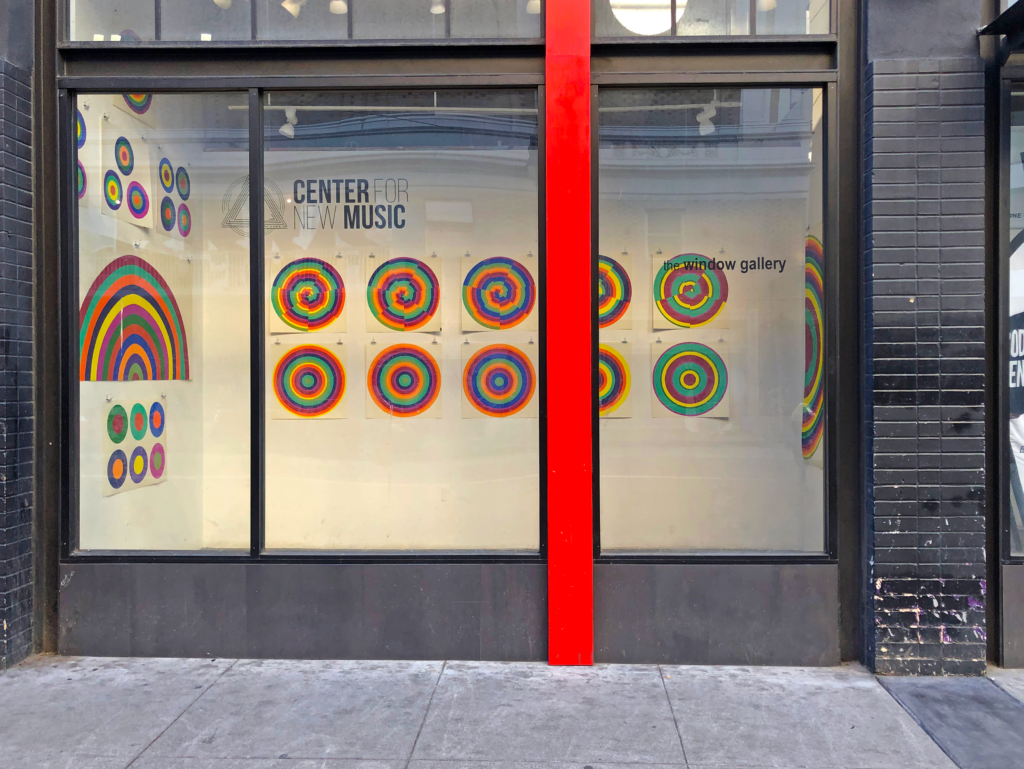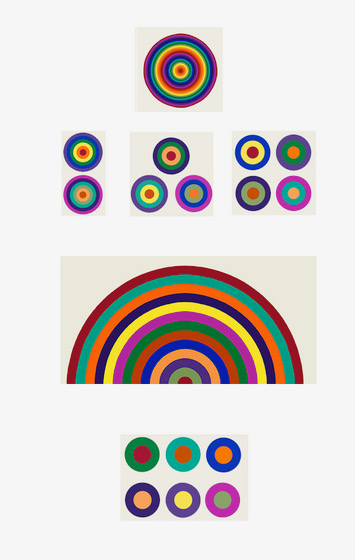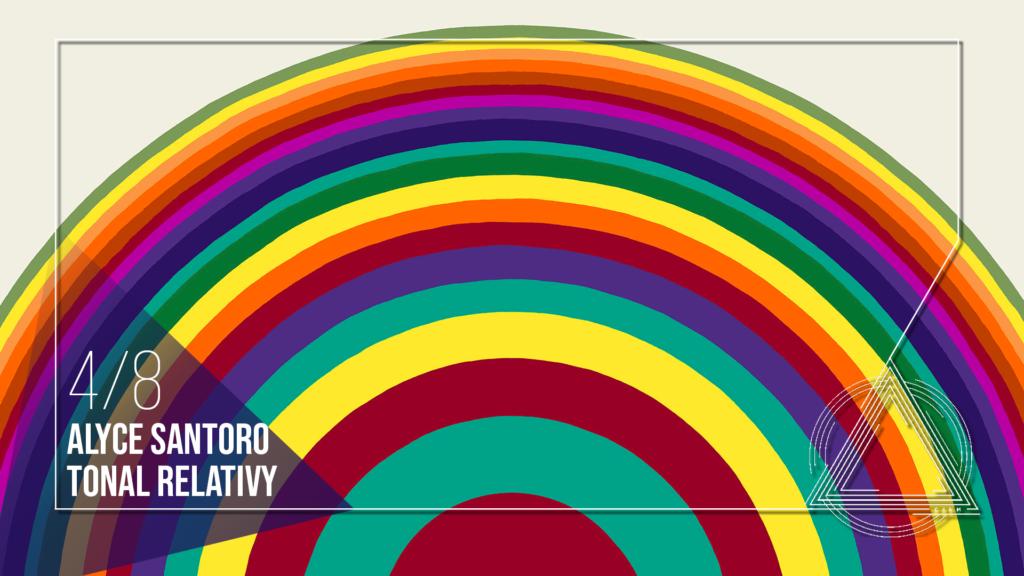Alyce Santoro will be discussing her work with David Samas on 4/8 at 5pm on YouTube Live.
The gallery will be open on 3/28 and 4/11 from 11am until 2pm. Reservations are required. Showings will be 20 minutes and only for small groups and individuals. Please contact annemarie@centerfornewmusic.com for information and booking.
About Tonal Relativity: Studies
The Tonal Relativity Studies are diagrams of musical intervals and sets of intervallic patterns for the purposes of contemplation and exploration (sonic, visual, or otherwise). A musical scale employing twelve equally-spaced tones is represented by a spectrum of 12 equally-spaced colors (from this basic concept, patterns derived from scales consisting of any number of tones or intervals can be imagined).
The current edition of the project employs concentric circles at a scale of ½ inch = ½ step in both color and pitch; one octave therefore equals 6”. The prints displayed at the Center for New Music began as sketches in gouache on paper, all completed during 2020.
Any color can be associated with any pitch; all colors/pitches remain relative. For the sake of consistency and legibility, a somewhat arbitrary choice was made to use red as a starting point for all graphics in this collection.
The Studies consist of three parts: Intervals, Modes/Scale Sets, and the Overtone Series.

TONAL RELATIVITY – STUDIES
“I think music is an instrument. It can create the initial thought patterns that can change the thinking of the people.” — John Coltrane, 1966 Interview with Frank Kofsky for KPFK Radio
An obvious yet fascinating feature of the human sensory system is that impressions evoked by color or sound shift according to context; the qualities of even a (seemingly) singular tone morph as pitches or hues are added. For many musicians, visual artists, and others, intentional focus on such basic relationships can serve as an entry into the appreciation of subtleties and the exploration of more intricate and complex interactions. Sensations, atmospheres, moods, and ideas can be communicated fluidly by those versed in the arts of tonal interactions.
The Tonal Relativity Studies offer a way of contemplating sound through color, and color through sound. They can be utilized by anyone interested in developing new pallets of possibility, sonic, visual, or otherwise.
Here a musical scale employing twelve equally-spaced tones is represented by a spectrum of 12 equally-spaced colors. For the sake of consistency and legibility, a somewhat arbitrary choice was made to use red as a starting point for all graphics in the current collection.
These diagrams are intended only as a starting point; patterns derived from scales consisting of any number of tones or intervals can be imagined using similar methods.
PART 1: INTERVALS
 The interval series begins with a 2-octave chromatic scale—twelve rings consisting of all consecutive colors/tones repeated twice.
The interval series begins with a 2-octave chromatic scale—twelve rings consisting of all consecutive colors/tones repeated twice.
Next, a set of two diagrams each consisting of every other color on the spectrum represent, in musical terms, two possible sets of whole tone scales. In color theory, these would be considered a set of six primary colors, and a set of six corresponding secondary and tertiary colors.
A set of three diagrams each consisting of four colors one-and-a-half steps apart on the spectrum represent three sets of stacked minor thirds. In terms of color, these relationships are known as tetrads.
A set of four diagrams each consisting of three colors two steps apart on the spectrum represent four sets of stacked major thirds. In color theory, these relationships are known as triads.
A half-circle (depicted at the same scale as the other graphics, but as a half-circle due to size constraints) consists of twelve colors two-an-a-half steps apart on the spectrum. From center out, this chart represents fourths. From outer edge to center, it represents fifths. In terms of color, these relationships are considered split complementaries (directly opposite one another on the color wheel, offset by one).
The set of six diagrams consisting of two colors three whole steps apart represent tritones. In color theory, these colors—exactly opposite one another on a tertiary (12-hue) color wheel—are known as complementary.
PART 2: MODES/SCALE SETS

These sets of intervallic patterns can be imagined as three-dimensional, extending infinitely in all directions (as if each view is a slice of a ball-shaped object).
Each of the five images in the top row consists of complexes of intervallic patterns. Left to right, the first three are 7-note scales (Modes of the Major Scale, Modes of the Melodic Minor Scale, Modes of the Harmonic Minor Scale, respectively). The rightmost two are 5-note (pentatonic) scales.
Each of the five images in the bottom row depict an individual scale extracted from the complex above it.
PART 3: THE OVERTONE SERIES

Most pitches emanating from a string or tube behave according to a physical phenomenon known as the Overtone Series. The oscillations of a primary tone in turn cause additional pitches to sound, resulting in a subtle cacophony contained within a seemly-singular tone. The order in which this subtle cacophony occurs in part forms the basis for musical scales around the world, and accounts for the variations in timbre of different voices and instruments.
In musical terms, the order is:
Prime, octave, fifth, octave, major third, fifth, minor seventh, octave, major second (or ninth), major third, tritone (sharp eleventh), fifth, minor sixth, minor seventh, major seventh, octave, minor second, major second, minor third, major third…and so on.
About Alyce Santoro
Informed by a background in biology, scientific illustration, and the environmental humanities, Alyce Santoro uses invented frameworks for experimentation, collage (sonic and visual), drawing, and writing to undo undue dualisms, explore new imaginaries, and otherwise remark on existence within an intricate ensemble.
Over the past 25 years, her multimedia works have appeared in over 50 exhibitions related to innovative textiles; experimental musical scores; sound and listening; social/environmental action; and the intersection of science and art.
Website: alycesantoro.com
